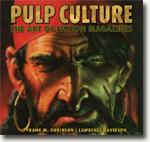Pulp Culture
R.J.B. Bosworth
book reviews:
· general fiction
· chick lit/romance
· sci-fi/fantasy
· graphic novels
· nonfiction
· audio books
· author interviews
· children's books @
curledupkids.com
· DVD reviews @
curledupdvd.com
newsletter
win books
buy online
links
home
for authors
& publishers
for reviewers

 |
Pulp Culture: The Art of Fiction Magazines Frank M. Robinson and Lawrence Davidson Collectors Press Paperback 206 pages January 2007 |
|
Pulp fiction has entered into the age of nostalgia with current authors, artists, and even filmmakers returning to embrace those long-gone genre tales. Whether it is Stephen King waxing poetic about the influence of pulp magazines or the cinematic impression of “pulp fiction” imbued upon films such as Sin City and Sky Captain and the World of Tomorrow, it becomes obvious that those poor-quality-paper books left a lasting impression on the world. Frank Robinson and Lawrence Davidson are here to remind us of the origins and some of the more popular series that capture imaginations back then and could probably do so again today.
From the exotic to the clichéd, the authors deliver a variety of essays exploring the different genres, writers, and styles not only within individual magazines, but also over the years as pulp magazines rose and fell in popularity. Essentially, these essays look at history more than literary deconstruction or a cultural study of the industry, but readers still walk away with a decent understanding of the dramatic rise and fall of pulp fiction. While the essays are particularly deep in their reasoning or explanations, there is not an expectation of it in this over-sized coffee book. But where this book really shines is in the hundreds of color pictures on almost every page. These images reveal the many different covers that pulp magazines used throughout the years. Interestingly, much like pornography today, the cover art was given the most attention and detail, often to the detriment of the contents. The idea was (and still is) to get readers’ attention in a newsstand virtually wallpapered with dozens, if not hundreds, of pulp magazines. The problem was how to stand out. Many of the artists who did the art work for these covers went on to other famous work or transitioned into related fields such as comic books or paperback (think romance) covers. But the selection of covers is astounding. In full color and varying in size from two inches to a full half page, each picture is accompanied by a caption revealing the title and number as well as a witty or informative one-liner. The artwork itself evokes interesting commentary on issues of race, gender, and violence. The implications of postures, coloring, and titles would prove a great study on institutional influences derived from such locations of pop culture. With some pages having as many as six covers, repeated scanning of this book will be necessary to fully enjoy it. However, for most who pick up this book, that will not seem to be labor but delight as this cornucopia of pulp magazines provides plenty of eye candy and food for thought. Originally published on Curled Up With A Good Book at www.curledup.com. © Lance Eaton, 2007 |
| Also by Frank M. Robinson: |
|
|
|
 Click here to learn more about this month's sponsor! |
|
| fiction · sf/f · comic books · nonfiction · audio newsletter · free book contest · buy books online review index · links · · authors & publishers reviewers |
|
| site by ELBO Computing Resources, Inc. | |
 At the turn of the century, as printing became more accessible and color printing more possible, a new form of literature emerged (though some might object to the use of the term “literature). As Poe and others had made the short story popular, these magazines, much like their predecessors the dime novels, were cheap and provided decent entertainment for millions of people worldwide. Known as pulp fiction or pulp magazines, these thick collections were printed on cheap yellowish paper, from which the name “pulp” was derived. As the initial magazines became popular, many spawned replicas and outright impostors, flooding the market but satisfying a hungry audience.
At the turn of the century, as printing became more accessible and color printing more possible, a new form of literature emerged (though some might object to the use of the term “literature). As Poe and others had made the short story popular, these magazines, much like their predecessors the dime novels, were cheap and provided decent entertainment for millions of people worldwide. Known as pulp fiction or pulp magazines, these thick collections were printed on cheap yellowish paper, from which the name “pulp” was derived. As the initial magazines became popular, many spawned replicas and outright impostors, flooding the market but satisfying a hungry audience.